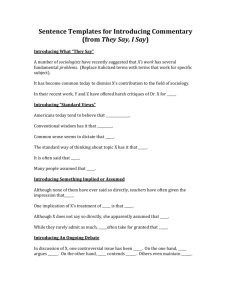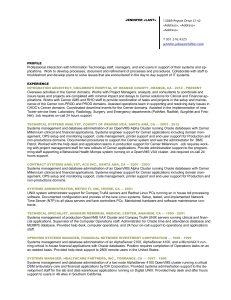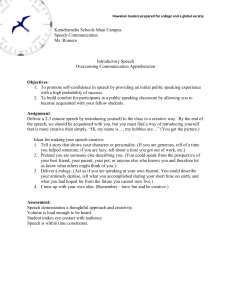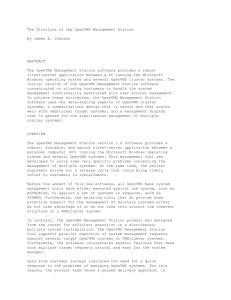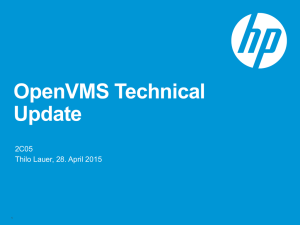Introducing eCube Systems
advertisement
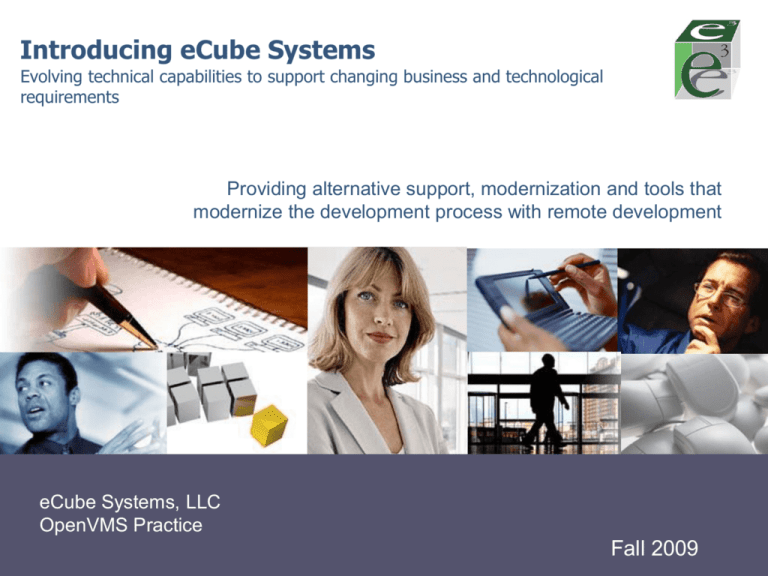
Introducing eCube Systems Evolving technical capabilities to support changing business and technological requirements Providing alternative support, modernization and tools that modernize the development process with remote development eCube Systems, LLC OpenVMS Practice Fall 2009 LOGO Introducing eCube Systems Introducing eCube Systems Modernization and Development Tools Specialists Providing solutions to the Fortune 1000 Product and services clients include: Barclaycard, Barclay Global Investors, United Healthcare, Lockheed, Bank of New York and IBM Partners/Associations: HP, IBM, SOA Software, OMG, Eclipse Foundation, Connect Background: Borland Software, Cray, Visigenic, DEC/HP veterans Resources: 3 US Offices, growing resources in Europe and Asia Introducing eCube Systems Modernization and Development Tools Specialists Core Competencies Enterprise-class distributed middleware Remote development tools Applications analysis and maintenance Legacy to SOA integration Custom Eclipse tooling and development Introducing eCube’s HP OpenVMS Practice Introducing eCube’s HP OpenVMS Practice Key Personnel Kevin Barnes Managing Partner kbarnes@ecubesystems.com Robert Doyle Chief Architect rdoyle@ecubesystems.com Sue Skonetski VP Client Relationships sue@ecubesystems.com Barry Kierstein Product Manager Bkierstein@ecubesystems.com Peter John Marquez Sr. Partner Peter@ecubesystems.com Stephen Hoffman Consulting Partner hoff@hoffmanlabs.com Introducing eCube’s HP OpenVMS Practice Key Offerings Targeted Offerings NXTware Remote for OpenVMS: Eclipse-based tooling for engineers tasked with OpenVMS development, maintenance, modernization and integration Related Products and Offerings Alternative Support: OpenVMS platform, application and middleware support, consolidation and maintenance NXTware Remote for UNIX/LINUX: Remote application development and maintenance ARM: Application assessment, remediation and modernization NXTware IME (Integrated Maintenance Environment) for RPC, DCE, CORBA: Middleware application development, maintenance and SOA enablement Introducing NXTware Remote Introducing NXTware Remote Remote development suite for OpenVMS Benefits Reduced complexity Lower cost of operation • Developers work with their language of choice on OpenVMS Greater productivity • Experienced OpenVMS developers and novices get more done Enhanced flexibility • Extends OpenVMS business logic to Java and Web Services Improved ROI • Extending the value of existing assets by applying the power of open source Introducing NXTware Remote Remote development suite for OpenVMS Features Integrated visual development environment Cross-language support: C, COBOL, Fortran, Pascal, BASIC, Java Remote development from Windows or Linux workstation Remote OpenVMS service execution engine Full integration with OpenVMS environment: DCL, MMS and CMS support Integration of custom client utilities SOA federation of existing business logic Introducing NXTware Remote NXTware Remote Architecture NXTware Remote Studio Multi-language Eclipse-based plug-ins for remote OpenVMS develop NXTware Remote Server Server-side platform-specific execution engine • OpenVMS version is DCL-based and talks with CMS, MMS, compiler and system NXTware Server Communication framework for remote development and distributed operation and management Introducing NXTware Remote NXTware Architecture Eclipse OpenVMS NXTware Server NXTware Remote Studio OpenVMS Tools NXTware Remote Server (IDE) Remote Communication Via CORBA NXTware Remote Solution NXTware Remote Powerful Benefits Solves real business challenges Operational Costs • Maintenance and integration Loss of Capability • Technical know-how, resources and human assets with contemporary tools Skills mismatch • Older platform and languages – Java developers Addresses the ROI Bell Curve… Bell Curve Reality Application Return on Investment and Risk Cycle Risk Bell Curve ROI Bell Curve ROI Risk Time Time As applications age, they become more expensive to maintain and the risk associated with their operation increases. If action isn’t taken, IT managers are eventually forced to start the cycle again, investing in a replacement system while carrying the risks related to new development or commercial software customization. ROI Bell Curve and Capability The Capability Wave breaks early... Assent: Development Development and implementation Capability/Skills high rate of growth... Apex: Mid-life Capability matures faster ROI plateaus after deployment Descent: Aging Dissipating capability • Technical skills tend to evaporate Higher cost of operation • Continually “Putting out fires” Software hardening • Increasing cost of handling changing business needs Capability NXTware Option Extending the ROI of Valuable Business Logic NXTware Remote extends the ROI Curve by Simplifying the use and maintenance of existing assets Managing changes in the market, technical standards and talent pools Limiting risks associated with re-engineering and software hardening Enabling selected business logic integration and extension with SOA and Web NXTware Remote Drives Efficiencies Existing Development NXTware-base Development Complexity Development Improved Manageability Maintenance Cost Rare skill sets Closed environment Time-to-market Responsiveness Constantly putting out “fires” Risk “Software hardening” Standards-based Develop in common environments Lower Cost of Operation Standard skill sets Interoperable with legacy and new applications Mitigated Risk Software Evolution Large Eclipse community of users Extended ROI No lost technical equity No high-cost re-engineering Thank You! Questions? Questions? This Presentation contains forward-looking statements based on beliefs of eCube Systems management. Such statements reflect current views of eCube Systems with respect to future events and results and are subject to risks and uncertainties. Actual results may vary materially from those projected here, due to factors including changes in general economic and business conditions, changes in currency exchange, the introduction of competing products, lack of market acceptance of new products, services or technologies and changes in business strategy.
